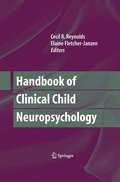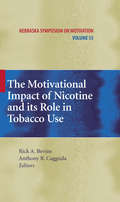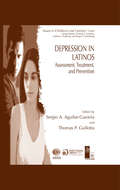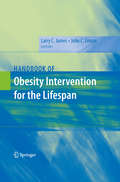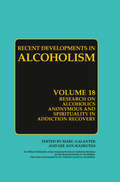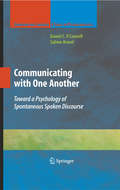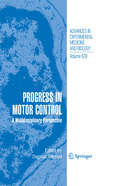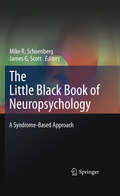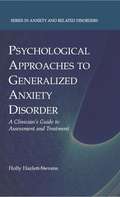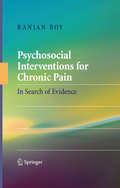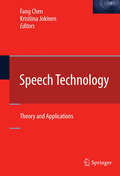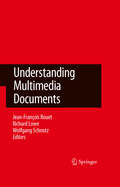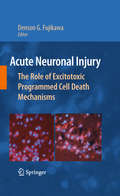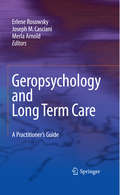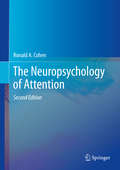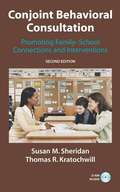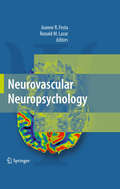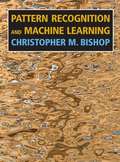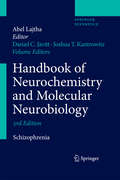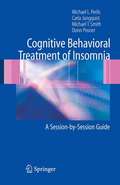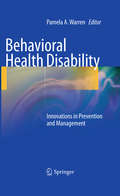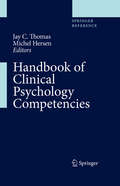- Table View
- List View
Handbook of Clinical Child Neuropsychology
by Elaine Fletcher-Janzen Cecil R. ReynoldsEvery chapter has been updated to reflect current thought and research in the field. Chapters devoted to specialized tests in neuropsychology have been updated to reflect new editions of these popular instruments. Special topic chapters have been added such as working in pediatric coma rehabilitation, using the planning, attention, sequential, simultaneous theory of neuropsychological processes, additions on ADHD, and more appear written by the leading experts and practitioners in these fields to reflect the demands of current practice in clinical child neuropsychology.
The Motivational Impact of Nicotine and its Role in Tobacco Use
by Anthony R. Caggiula Rick A. BevinsThe Motivational Impact of Nicotine and its Role in Tobacco Use draws upon research on the drug widely believed to form the basis of tobacco use and dependence, nicotine. When discussing drug addiction and dependence, an increasing number of scientists are using the concepts of motivation and related constructs (e.g., incentive processes, cravings, drug seeking, etc.) and their applications in modifying behavior. The chapter authors discuss effective strategies for decreasing tobacco use and preventing initiation through a translational approach in which genetic, neurobiological, individual, and cultural factors motivating tobacco use and nicotine dependence are considered.
Depression in Latinos
by Thomas P. Gullotta Sergio A. Aguilar-GaxiolaDepression ranks as a leading mental health problem among Hispanic immigrants and their US-born children. And a wide array of issues - starting with the widespread stereotype of the "illegal immigrant" - makes the Latino experience of this condition differ from that of any other group. Depression in Latinos consolidates the conceptual, diagnostic, and clinical knowledge based on this salient topic, providing coverage from prevalence to prevention, from efficient screening to effective interventions. In this concise yet comprehensive volume, leading clinicians, researchers, and academics offer extensive research and clinical findings, literature reviews (e.g., an in-depth chapter on the Mexican American Prevalence and Services Survey), and insights gathered from first-hand experience in clinical practice. Perceptive information is offered on the most urgent and complex issues on depression in this diverse and dynamic population, including: (1) The impact language, culture, and societal factors have on depression and its diagnosis. (2) The most relevant assessment instruments. (3) How depression manifests among Latino children, youth, and seniors as well as in Latinas. (4) The relationship between depression and substance abuse. (5) The most effective evidence-based treatment methods. (6) The efficacy of interventions for depression at the community level. Depression in Latinos is vital reading for clinicians, counseling and school psychologists, psychiatrists, clinical social workers, and public health professionals interested in providing their Hispanic clients with the most effective treatment possible. In addition, its coverage of the broader issues of access to care makes this volume essential reading for mental health administrators, volunteer/outreach agencies, and policymakers.
Handbook of Obesity Intervention for the Lifespan
by Larry James John C. LintonEnvironmental, genetic, psychological, and societal factors interact to produce obesity, a chronic condition of epidemic proportions. The Handbook of Obesity Intervention for the Lifespan guides professionals in meeting this complex challenge with a multidisciplinary palette of evidence-based interventions that can be tailored to men and women across the lifespan, regardless of background. This unique reference combines salient research data and hands-on clinical applications for use with overweight patients, from the very young to the very old, and includes a "treatment resources" section with extra materials to bolster therapy--all geared toward respectful, encouraging treatment and lasting weight-loss results.
Education Outreach and Public Engagement
by Erin DolanThe purpose of this series is to provide resources related to teaching and career development for faculty at all stages of their careers and to scientists considering careers in industry. Young faculty (or graduate students and post docs thinking about going into academia) will find valuable information about how to design a course, how to find the right job, including academia and industry, and how to incorporate undergraduate research into their programs.
Research on Alcoholics Anonymous and Spirituality in Addiction Recovery
by Marc Galanter Lee Anne KaskutasIt was once taken for granted that peer-assisted groups such as Alcoholics Anonymous had no "real" value in recovery from addiction. More recently, evidence-based medicine is recognizing a spiritual component in healing--especially when it comes to addiction. The newest edition of Recent Developments in Alcoholism reflects this change by focusing on the 12-step model of recovery as well as mindfulness meditation and other spiritually oriented activity. More than thirty contributors bring together historical background, research findings, and clinical wisdom to analyze the compatibility of professional treatment and nonprofessional support, day-to-day concepts of relapse prevention, the value of community building in recovery, and much more. Among the topics covered: (1) How and why 12-step groups work. (2) The impact of the spiritual on mainstream treatment. (3) The impact of AA on other nonprofessional recovery programs. (4) AA outcomes for special populations. (5) Facilitating involvement in 12-step programs. (6) Methods for measuring religiousness and spirituality in alcohol research. Whether one is referring clients to 12-step programs or seeking to better understand the process, this is a unique resource for clinicians and social workers. Developmental psychologists, too, will find Volume 18--Research on Alcoholics Anonymous and Spirituality in Addiction Recovery a worthy successor to the series.
Communicating with One Another: Toward a Psychology of Spontaneous Spoken Discourse (Cognition and Language: A Series in Psycholinguistics)
by Sabine KowalIn contrast to traditional approaches of mainstream psycholinguists, the authors of Communicating with One Another approach spontaneous spoken discourse as a dynamic process, rich with structures, patterns, and rules other than conventional grammar and syntax. Daniel C. O'Connell and Sabine Kowal thoroughly critique mainstream psycholinguistics, proposing instead a shift in theoretical focus from experimentation to field observation, from monologue to dialogue, and from the written to the spoken. They invoke four theoretical principles: intersubjectivity, perspectivity, open-endedness, and verbal integrity. Their analyses of historical and original research raise significant questions about the relationship between spoken and written discourse, particularly with regard to transcription and punctuation. With emphasis on political discourse, media interviews, and dramatic performance, the authors review both familiar and unexplored characteristics of spontaneous spoken communication, including: (1) The speaker's use of prosody. (2) The functions of interjections. (3) What fillers do for a living. (4) Turn-taking: Smooth and otherwise. (5) Laughter, applause, and booing: from individual listener to collective audience. (6) Pauses, silence, and the art of listening. The paradigm shift proposed in Communicating with One Another will interest and provoke readers concerned about communicative language use - including psycholinguists, sociolinguists, and anthropological linguists.
Progress in Motor Control
by Dagmar SternadThis ground-breaking book brings together researchers from a wide range of disciplines to discuss the control and coordination of processes involved in perceptually guided actions. The research area of motor control has become an increasingly multidisciplinary undertaking. Understanding the acquisition and performance of voluntary movements in biological and artificial systems requires the integration of knowledge from a variety of disciplines from neurophysiology to biomechanics.
The Little Black Book of Neuropsychology
by Mike R. Schoenberg James G. ScottFrom translating the patient's medical records and test results to providing recommendations, the neuropsychological evaluation incorporates the science and practice of neuropsychology, neurology, and psychological sciences. The Little Black Book of Neuropsychology brings the practice and study of neuropsychology into concise step-by-step focus--without skimping on scientific quality. This one-of-a-kind assessment reference complements standard textbooks by outlining signs, symptoms, and complaints according to neuropsychological domain (such as memory, language, or executive function), with descriptions of possible deficits involved, inpatient and outpatient assessment methods, and possible etiologies. Additional chapters offer a more traditional approach to evaluation, discussing specific neurological disorders and diseases in terms of their clinical features, neuroanatomical correlates, and assessment and treatment considerations. Chapters in psychometrics provide for initial understanding of brain-behavior interpretation as well as more advanced principals for neuropsychology practice including new diagnostic concepts and analysis of change in performance over time. For the trainee, beginning clinician or seasoned expert, this user-friendly presentation incorporating 'quick reference guides' throughout which will add to the practice armentarium of beginning and seasoned clinicians alike. Key features of The Black Book of Neuropsychology: Concise framework for understanding the neuropsychological referral. Symptoms/syndromes presented in a handy outline format, with dozens of charts and tables. Review of basic neurobehavioral examination procedure. Attention to professional issues, including advances in psychometrics and diagnoses, including tables for reliable change for many commonly used tests. Special "Writing Reports like You Mean It" section and guidelines for answering referral questions.Includes appendices of practical information, including neuropsychological formulary. The Little Black Book of Neuropsychology is an indispensable resource for the range of practitioners and scientists interested in brain-behavior relationships. Particular emphasis is provided for trainees in neuropsychology and neuropsychologists. However, the easy to use format and concise presentation is likely to be of particular value to interns, residents, and fellows studying neurology, neurological surgery, psychiatry, and nurses. Finally, teachers of neuropsychological and neurological assessment may also find this book useful as a classroom text. "There is no other book in the field that covers the scope of material that is inside this comprehensive text. The work might be best summed up as being a clinical neuropsychology postdoctoral residency in a book, with the most up to date information available, so that it is also an indispensible book for practicing neuropsychologists in addition to students and residents...There is really no book like this available today. It skillfully brings together the most important foundationsof clinical neuropsychology with the 'nuts and bolts' of every facet of assessment. It also reminds the more weathered neuropsychologists among us of the essential value of neuropsychological assessment...the impact of the disease on the patient's cognitive functioning and behavior may only be objectively quantified through a neuropsychological assessment." Arch Clin Neuropsychol (2011) first published online June 13, 2011 Read the full review acn.oxfordjournals.org
Psychological Approaches to Generalized Anxiety Disorder
by Holly Hazlett-StevensConcise, yet without skimping on information, this book reviews current theory and research, addresses important diagnostic issues, and provides salient details in a number of key areas related to GAD. Assessment procedures and treatment planning are covered, along with the latest therapy outcome data, including findings on newer therapies. Also detailed are specific cognitive behavioral therapy techniques, including cognitive strategies, psychoeducation, and anxiety monitoring.
Death Threats and Violence
by Stephen MorewitzThis fascinating work analyzes the meaning and impact of homicidal threats, the means by which they are communicated, and their development from infrequent private occurrence to ongoing social problem. Using data from the Stalking and Violence Project and recent events including the Virginia Tech massacre, Stephen Morewitz explores the lives of the men (and to a lesser degree, women) who make threats against their partners, strangers, social groups, and institutions.
Psychosocial Interventions for Chronic Pain
by Ranjan RoyThis book fills a major gap in the practice literature for healthcare professionals engaged in providing psychosocial care for their patients suffering from chronic pain or illness. Up to now there has been little published material on evidence-based medicine in this field. Roy's book at last provides empirically derived support and understanding of psychosocial problems and explores the efficacy of the interventions available for patient care. A boon for clinical psychologists.
Speech Technology: Theory and Applications (Wiley Series In Agent Technology Ser. #11)
by Kristiina Jokinen Fang ChenThis book gives an overview of the research and application of speech technologies in different areas. One of the special characteristics of the book is that the authors take a broad view of the multiple research areas and take the multidisciplinary approach to the topics. One of the goals in this book is to emphasize the application. User experience, human factors and usability issues are the focus in this book.
Understanding Multimedia Documents
by Richard Lowe Jean-Francois Rouet Wolfgang SchnotzProfessionals who use multimedia documents as a tool to communicate concepts will find this a hugely illuminating text. It provides a comprehensive and up to date account of relevant research issues, methodologies and results in the area of multimedia comprehension. More specifically, the book draws connections between cognitive research, instructional strategies and design methodologies. It includes theoretical reviews, discussions of research techniques, ad original experimental contributions. The book highlights essential aspects of current theories, and trends for future research on the use of multimedia documents.
Acute Neuronal Injury: The Role of Excitotoxic Programmed Cell Death Mechanisms
by Denson G. FujikawaThe purpose of this book is to present clinically relevant basic mechanisms of excitotoxic neuronal death, which in the adult mammalian brain is morphologically necrotic, not apoptotic, and which involve caspase-independent mechanisms of programmed cell death. The spectrum of clinically relevant pathologically induced excitotoxic neuronal death includes cerebral ischemia, traumatic brain injury, cerebral hypoglycemia, and status epilepticus. By investigating mechanisms, potential neuroprotective strategies can be identified that may have future clinical application.
Geropsychology and Long Term Care
by Erlene Rosowsky Merla Arnold Joseph M. CascianiThe ever-increasing population of older adults residing in nursing homes and long-term care communities, as reflected in numerous demographic studies, point out a clear need for geropsychologists i.e., trained specialists in the field of aging and mental health, to meet the needs of this nation's older adults. This book will provide a needed resource for psychologists working in long-term care settings and those who wish to do so. Key outcomes include the provision of high quality psychological services for this important but neglected sector namely, people living in nursing homes, assisted living communities and other LTC settings. This text will be of great value to psychologists currently working in long-term care settings who have had graduate work in geropsychology, yet desire more in-depth and practical training. A second audience includes those individuals who may have a leaning towards expanding their professional activities in long-term care and are seeking additional preparation before doing more work with older adults. A third group is comprised of those individuals who are not psychologists, yet have had some training and coursework in aging and mental health.
The Neuropsychology of Attention
by Ronald A. CohenIt has been 15 years since the original publication of Neuropsychology of Attention. At the time of its publication, attention was a construct that had long been of theoretical interest in the field of psychology and was receiving increased research by cognitive scientists. Yet, attention was typically viewed as a nuisance variable; a factor that needed to be accounted for when assessing brain function, but of limited importance in its own right. There is a need for a new edition of this book within Neuropsychology to present an updated and integrated review of what is know about attention, the disorders that affect it, and approaches to its clinical assessment and treatment. Such a book will provide perspectives for experimental neuropsychological study of attention and also provide clinicians with insights on how to approach this neuropsychological domain.
Conjoint Behavioral Consultation: Promoting Family-school Connections and Interventions (Second Edition)
by Susan M. Sheridan Thomas R. Kratochwill Jennifer D. Burt Brandy L. Clarke Shannon Dowd-Eagle Diane C. MartiChildren learn within many systems and settings. In the United States, students spend 91% of their time from birth to the age of 18 outside of school. Once in school, they spend 70% of their waking hours outside of school.
Educational Innovations Beyond Technology
by Robert Fox Allan Yuen Nancy LawThe text explores the concept of innovation, and analyse and compare different dimensions of innovation found in the various case studies; the transfer of innovation and the mechanisms of change; on an innovative online case study database on education innovations that has been designed to be used by education practitioners to support organizational leadership, international collaboration and reflective practice in the Asia Pacific Economic Cooperation (APEC) eEducation Leadership initiative; on a project aimed to support the establishment of communities of practice for education practitioners facilitated through an extendable online database that can be used to contribute and share case studies of their own ICT-supported pedagogical innovations. It discusses roles of the teacher and the anticipated changes to the education profession at a system level, in the coming decade on the basis of emerging changes observed in the case studies, and leadership issues at the school level. The book analyses change mechanisms for different kinds of innovation and how different contextual and cultural factors interact to bring about the changes observed.
Neurovascular Neuropsychology
by Joanne Festa Ronald Lazar J. P. MohrNeurovascular diseases and conditions, and their associated risk factors, represent a significant cause of cognitive disability in the United States and throughout the world. In the USA alone there are 750,000 new strokes each year, representing the number one cause of disability in the country. Hypertension, found in approximately 50 million Americans, has been shown to be associated with alterations of cognitive function, even in the absence of stroke and dementia. Recent studies of neurovascular disease have now revealed that neuropsychological function may be a more sensitive measure of brain integrity than coordination, motor or sensory function and correlates will with functional outcome measures. Neurovascular Neuropsychology focuses on focal and diffuse neurovascular disease in addition to systemic conditions in which cognition and behavior have been uniquely associated with different pathologic states. With an increasing number of patients being treated by healthcare professionals, Neurovascular Neuropsychology will prove to be a strong reference to consult in regards to neuropsychological syndromes.
Pattern Recognition And Machine Learning (Information Science And Statistics)
by Christopher M. BishopThis is the first textbook on pattern recognition to present the Bayesian viewpoint. The book presents approximate inference algorithms that permit fast approximate answers in situations where exact answers are not feasible. It uses graphical models to describe probability distributions when no other books apply graphical models to machine learning. No previous knowledge of pattern recognition or machine learning concepts is assumed. Familiarity with multivariate calculus and basic linear algebra is required, and some experience in the use of probabilities would be helpful though not essential as the book includes a self-contained introduction to basic probability theory.
Handbook of Neurochemistry and Molecular Neurobiology
by Abel Lajtha Joshua Kantrowitz Daniel C. JavittThis volume of the Handbook of Neurochemistry and Molecular Neurobiology focuses on neurochemical aspects of schizophrenia. Chapters cover the full range of schizophrenia symptoms and anatomical pathologies from neurochemical and molecular biology perspectives. Topics include changes in neurotransmitter systems, alteration in receptors, neurotransmitter release, genetic factors, protein alterations, and redox dysregulation.
Cognitive Behavioral Treatment of Insomnia: A Session-by-Session Guide
by Carla Jungquist Donn Posner Michael T. Smith Michael L. PerlisCognitive behavior therapy which has been adapted to treat so many problems, has also brought data-driven and data-yielding treatment to insomnia. Focusing on this evidence-based modality, Cognitive Behavioral Treatment of Insomnia is a much-needed treatment manual that provides clinicians with the why’s and how’s of this approach in concise and practical terms. This book, which is written as a reader-friendly guide, is intended for clinical trainees, non-insomnia sleep specialists, and for expert CBT clinicians from outside the sleep medicine field who wish to begin the process of learning to provide empirically validated CBT-I.
Behavioral Health Disability: Innovations in Prevention and Management
by Pamela A WarrenThe purpose of this book is to demystify the evaluation and management of common psychological disorders and psychosocial issues which impact all realms of medical and mental health practice. These types of issues are often seen as "medical quicksand" by treating professionals, employers, and insurers alike. Consequently, there is a system-wide avoidance of these disorders that significantly increase medical and disability costs. However, there is a considerable cost to individual and society as well in terms of the reduction in the quality of life of the individual and the high costs associated with chronic use of medical resources. It is essential to note the complexity of the psychiatric and psychosocial disability conundrum. This dilemma is not limited solely to short-term, minor problems but leach into the full spectrum of disability systems: private insurance, disability insurance, and federal programs for disabled persons. This book will provide innovative tools to confidently navigate the disability process by implementing, for the first time, true objective information coupled with the state-of-the-art evidence-based research. Thus, all individuals involved in the psychiatric disability process will be able to properly manage the process, optimize the treatment for an optimal outcome and avoid iatrogenic disability. In particular, the book will provide a clear evidence-based guidance for the evaluation and treatment process not only for individuals with obvious psychological problems, but for symptomatic individual with no discernable etiology or who simply never seem to get well.
Handbook of Clinical Psychology Competencies
by Michel Hersen Jay C ThomasThis three-volume handbook describes the core competency areas in providing psychological services relevant to practitioners as well as clinical researchers. It covers assessment and conceptualization of cases, the application of evidence-based methods, supervision, consultation, cross-cultural factors, and ethics.
